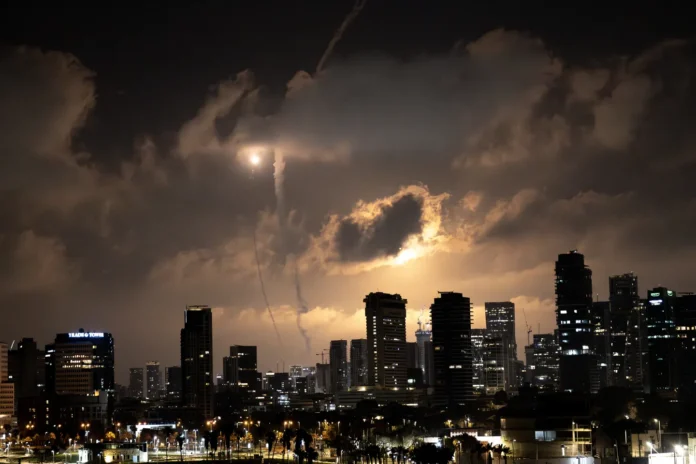Tel Aviv, June 25, 2025 — The 12-day military confrontation between Israel and Iran has inflicted massive economic damage on Israel, with losses potentially exceeding $20 billion, according to multiple financial experts and credible institutions. The fallout has already led to a spike in Israel’s budget deficit, disrupted vital infrastructure, and triggered panic across financial markets.
Heavy Military Expenditures Confirmed by Analysts
According to The Financial Express, Israel spent approximately $5 billion during the first week of the conflict, while daily war expenditures reached $725 million. This included:
- $593 million for offensive operations
- $132 million for defense systems and troop mobilization
These numbers align with data from the Aaron Institute for Economic Policy (Israel), which estimated that if the conflict had lasted a full month, total expenditures could have exceeded $12 billion.
Additionally, The Wall Street Journal reported that daily operating costs of Israel’s missile defense systems—including Iron Dome, Arrow, and David’s Sling—varied between $10 million and $200 million, depending on the intensity of incoming threats.
Broader Economic Impact: Up to $20 Billion in Direct and Indirect Losses
Dr. Naser Abdelkarim, a finance professor at the American University of Palestine, told Al Jazeera Arabic that indirect losses—including production slowdowns, evacuation costs, and disrupted infrastructure—could raise the total economic toll to $20 billion.
He added that Israel’s budget deficit is expected to increase by 6%, further straining the economy, especially with compensation demands from over 36,465 displaced or affected civilians, as reported by the Israel Tax Authority.
“The government is considering cuts to health and education, tax hikes, or borrowing to cover the deficit,” said Abdelkarim. “Public debt could rise above 75% of GDP if borrowing becomes the primary option.”
Government Budget Strained: Cuts and Reallocation Underway
The Israeli Ministry of Finance acknowledged in a public statement that it requested ₪3.2 billion (~$857 million USD) in emergency defense funding, while simultaneously recommending ₪750 million (~$200 million USD) in cuts to health, education, and social services.
Globes, Israel’s top business newspaper, reported that most of this new funding will go toward compensating military reservists, with 450,000 personnel mobilized during the escalation.
Investor Sentiment and Currency Hit
The Israeli shekel dropped to 3.7 per US dollar during the height of the conflict, per data from the Bank of Israel, before slightly recovering to 3.5, aided by central bank interventions and temporary dollar weakness.
Investor confidence has taken a severe hit. According to the Israel Diamond Institute, Iranian missile strikes hit areas adjacent to the Tel Aviv Diamond Exchange, which accounts for approximately 8% of Israel’s total exports. The Tel Aviv Stock Exchange (TASE) saw a wave of sell-offs as concerns mounted over both infrastructure damage and instability in export sectors.
Key Infrastructure Damaged: Oil, Air Travel, and Export Hubs
The Financial Times confirmed that Iran targeted strategic infrastructure, including a missile strike on the Bazan Oil Refinery in Haifa—Israel’s largest refinery—causing an estimated $3 million in daily losses.
Meanwhile, Ben Gurion International Airport, Israel’s primary gateway, suspended all operations during peak escalation. The airport typically serves over 35,000 passengers and 300 flights daily, as per Israel Airports Authority data. The partial reopening, limited to repatriation flights, continues to constrain travel and tourism revenues.
The national airline El Al suspended and diverted several international flights. A Tel Aviv–Paris flight was rerouted to Cyprus, and a Tel Aviv–Bangkok flight landed in Rome, according to Haaretz. Estimated losses from diverted flights and operational adjustments have reached $6 million, said an El Al spokesperson quoted by The Marker, an Israeli business daily.
Outlook: Growth Threatened, Deficit Ballooning
Economic analysts warn that Israel’s GDP growth could slow significantly, especially if the regional situation remains unstable. The Bank of Israel is expected to revise its 2025 GDP forecast downward. Rising unemployment and reduced consumer confidence could exacerbate the strain on public finances.
Abdelkarim and other experts emphasize that the real economic cost will continue to accumulate, even after military operations end.
“It’s not just about the money spent on missiles or soldiers,” said Abdelkarim. “It’s the long-term damage to investor confidence, infrastructure, productivity, and public trust.”
The 12-day war may be over for now, but the economic consequences for Israel are likely to linger for months, if not years. With public spending under review, key industries under threat, and markets on edge, the Israeli government faces a pivotal moment in determining how to shield its economy from prolonged geopolitical shocks.
References:
- Financial Express (June 2025): Israel’s Military Expenditure Estimates
- The Wall Street Journal (June 2025): Iron Dome Operational Costs
- Aaron Institute for Economic Policy (Tel Aviv University): Conflict Economic Impact Report
- Financial Times (June 2025): Oil Refinery Strike Losses
- Israel Tax Authority (June 2025): Civilian Compensation Claims
- Bank of Israel: Exchange Rate Trends
- Israel Diamond Institute: Export Sector Impact
- Globes and The Marker: Government Budget and El Al Disruptions
- Haaretz: Airport and Flight Diversions
- Al Jazeera Arabic: Expert Commentary by Dr. Abdelkarim










